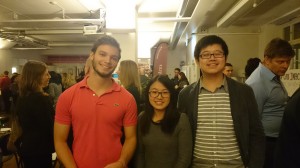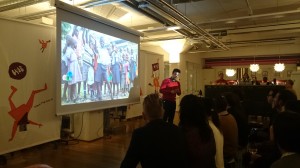Time for our very last blog post in this forum as the group Key Notion! Lately we’ve been discussing the relevance of this course, what we have learned, and how this will affect our future. Our first thought was that this was like any other course, but then we actually realized that a few things were very valuable! Maybe the most fun and interesting thing was our increased appreciation of the concept of networking! While many might consider it the boring necessity of business and entrepreneurship, this can actually be very fulfilling! We’ve all expanded our network and considering the diversity in this class, we’re sure that at least a few of the new connections will be relevant, both in our future fields of work, and even to our social lives!
We also realized that we’ve been given a plethora of tools to structure our ways of generating new ideas for entrepreneurial start-ups. We’ve learned the why-why-why-why-why method, and learned to really get to the core of what is important for the target customer! And we’ve also learned how-how-how-how-how to effectively sell our idea! Especially the means of bringing in capital through pitching and creating an effective business plan. We now feel more confident in our abilities in these fields, and the world of entrepreneurship no longer seems as intimidating!
Next up is Assignment 5, picking an idea and creating a new business venture concept! We will now quickly go through some individual thoughts about our five product ideas, and at the very end, we’ll announce the winner! Let the excitement begin!
—————————-
Katarina Allmér’s thoughts about “Can I crush?”
Living in a small student apartment, I realized how often I was annoyed by not having anywhere to put empty cans and bottles since they took up a lot of space that I wanted for other things. This made me think that if I could compress the cans I could easily store them without having to go to the store and deposit them as often, which led to the idea of a new product doing just that. When I talked to other people about my idea and asked for feedback, most of them were very positive and said it was something they might want for themselves. However, some did not think they had a need for it, and a general concern was the cost and how much space the machine itself would need. Therefore, some challenges in pursuing this idea would be to make the product both cheap enough and small enough for customers to think it was worth it, and since I don’t have much expertise in this field, I would need a lot of help with the development of the product. It is not unreasonable to think, though, that this product might have a place in the market of gadget-collecting people, if not for the average person.
Emma Bednarcik’s thoughts about “The Campus App”
As I saw the new students arriving at KTH and thought back at my first time at this university, I remembered the difficulties of finding all the scattered lecture halls, and also of finding a good place to eat. I then came up with the idea of creating a smartphone application with easily accessible and relevant information, helping new students with just these problems! The idea was to bring in revenue through making the app widespread and allowing restaurants to promote themselves to these relevant customers. The feedback I got when talking to students – both new and senior – was mostly positive; an app is so easy to download, and they’d all been in at least a few situations where this would have saved them from barging into the classroom, 10 minutes late. A requirement, however, was that it would have to be free. Due to the limited amount of new students (who would be the ones using this app the most), and the low market value of ad space, the revenue guesstimate , however, turned out unfavourable in relation to the work that would be required to start and maintain this business. So even if this is in theory a good and well received idea, it is unfortunately not a venture worth pursuing.
Sofia Feychting’s thoughts about “The Fall Watch”
My grandmother is 97 years old, sharp as a nail, and constantly winning at bridge. I am still worried that if she were to fall down she would not be able to get up by herself. Since she lives alone, this is a real problem. My business idea is a “Fall Watch”; a nicely designed watch that also functions as a fall alarm. If you fall down and can’t get up, you just press the button on the watch and it will send a signal to the cell phone of a relative. Some people might feel ashamed of buying a fall alarm but if the product is also a really nice and useful watch that will be less of a problem, and this differentiates the product from the competitors. I talked to several of my relatives and their friends and they confirmed that this product would definitely decrease all of the worrying and make the elderly person feel more secure in their home. Some of them requested a greater function with an automatic fall alarm and some of them worried that they might miss the phone call and leave their relative stranded. Adding more functions and services to the product can solve all of this, but this might also result in a hefty price tag and that could scare off customers. Will it be possible to combine great design with practical functions or will one of these aspects have to suffer, they wondered. There are some obvious founder-issues with this product. I have no design experience so I would have to gather a large team of people to develop this product for me, as well as the many possible add-ons. One way to solve this is to start simple without any of the add-ons, just a good design-team and hope that people still want to buy the product. If successful, the process can be iterated but with a larger team and more functions added to the product.
Martin Listén’s thoughts about “The Digital Map”
Living nearby my grandmother, who has started to become a bit confused, and seeing the pains which she experiences when she no longer feel fully safe about leaving home, even to do the simple things like going to the nearby store, and the pains which my mother and her siblings feel when a lot of their energy goes to helping her, I came up with the idea of The Digital Map. This would be a very simple GPS, showing the tracked movement of the user at all the time it’s turned on, and have no confusing functions for the user. The feedback I received when talking to my family, as well as other students who find their grandparents in similar situations, was positive in that the value proposition was enough to justify buying it even if it is not extremely cheap. However, the paradox in putting all responsibility on the person with dementia was not lost on people, and concerns about this aspect may end up being a deterrence for the target customer, and may have to be solved by adding, for example, functions for external tracking. Giving the large and growing numbers of people reaching dementia, and the fact that a decent profit margin might be achievable, I believe this idea might be worth looking further into.
Marina Vitez’s thoughts about “The Colour-Changing Thermos”
Text is being updated!
—————————-
These products are all fun or useful, and we would like to see them on the market! When picking one, however, we also looked at their ability to turn into a successful venture, and how big the pain they try to solve is. After careful contemplation, we came to the conclusion that the idea we would be the most passionate about pursuing, especially because of the lack of existing solutions, is *Drumroll* The Digital Map!





